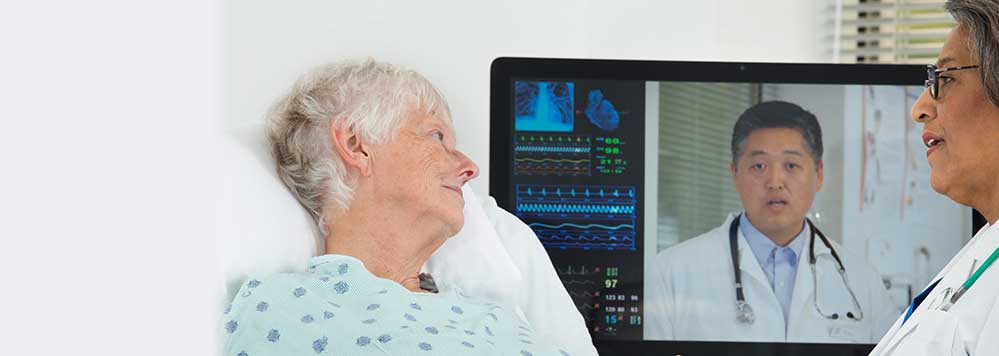Videoconferencing has already given people opportunities to meet with distant colleagues, friends and family without having to travel. This technology when used in health care — telehealth — is bringing an era of improved care delivery and access to quality and convenient care for patients.
Telehealth care comes with the clinical capability of an in-person visit but with the cost efficiency of a virtual visit. In 2018, telehealth was estimated to have saved Western Australian patients from traveling 17.7 million miles for outpatient appointments. That’s about 37 times to the moon and back.1
A recent survey revealed that 22% of physicians in the U.S. are using telehealth, a staggering 340% growth from about 5% in 2015.2 However, considering telehealth’s potential to address a multitude of problems in the health care industry — an aging population, huge costs and a shortage of physicians — the adoption rate hasn’t kept up with the technology. The low adoption rate could be attributed to regulatory and people related factors.
Telehealth — care delivery potential
Telehealth can be used to solve critical as well as minor health care problems. It can deliver care everywhere, anytime and for everyone in the most efficient and cost-effective manner. (Figure 1)
Figure 1. Care delivery using telehealth
Care delivery — everywhere
Telehealth technology can bridge the care access divide and reach people in remote and rural areas that still lack access to primary care. Patients in these regions can access medical services without traveling a long distance for an in-person visit. For example, the Mayo Clinic uses a tele neonatology program. Experienced neonatologists are able to handle high-risk neonatal emergencies using a real-time audiovisual connection with the care teams in remote community hospitals. This is used when local community caregivers have to handle high-risk newborns independently when a specialized team is not available due to weather or geography.3
Care delivery — anywhere
In-person visits or follow-ups can be stressful when patients have to take time off from work for simple medical issues. This either decreases employee productivity or increases cancellations for the provider. Adecco Group, a leading provider of HR solutions, with a number of employees who travel for work, was looking for affordable health care for its employees that they could access from anywhere.
Adecco provided its employees with a telehealth service. Over 28% of the employees enrolled in this program with an estimated cost savings of $130,000 in the first year. The average employee video visits lasted about six minutes in comparison to an estimated 121 minutes which includes travel and wait time for in-office doctor’s appointments.1 Added to this are employee productivity gains; patients do not have to take time away from work or pay for transportation or childcare.
Care delivery — anytime
Telehealth can help patients access emergency care anytime at far lower costs. For example, U.S.-based Jefferson Health added a feature for on-demand virtual care called JeffConnect®, which patients can use to connect with a physician. Using the on-demand app, physicians can diagnose and provide treatment for issues such as cold or flu, or advise whether the patient needs to visit the hospital for further diagnosis. The cost of such a visit is $49, which is much lower than any office visit or emergency visit. Also, the care is delivered at your convenience, where you are.5
Another example is the tele-ICU service that supports roughly 13% of intensive care units. At the University of Massachusetts Memorial Medical Center in Worcester, by using this technology, trained intensivists provide ICU care remotely. This has resulted in a 20% decrease in mortality and a 30% decrease in length of stay, thus reducing care costs.6
Care delivery — everyone
The U.S. is expected to be short of about 122,000 physicians by 2032 as demand continues to grow faster than supply.7 Telehealth can address this shortage by improving the productivity of the health care staff and enabling care delivery for everyone.
Dermatologists at Kaiser Permanente in San Diego can treat more patients by reviewing the images and patient information sent to them by referring physicians. The dermatology staff can now handle about 800 cases a month, 50% more than all in-person visits.8
Telehealth can help bridge the demand-supply gap in the availability of healthcare professionals in the US
In a program at Boston-based Partners HealthCare, around 3,000 patients used at-home monitoring services to send vital metrics such as weight and blood pressure to Partners. Clinical decision systems used artificial intelligence and other decision capabilities to identify a set of patients who needed interventions. Three to four nurses could provide care for over 250 patients, which reduced readmissions by 44% and saved over $10 million.
An analysis of three years of Medicaid claims for children under the age of 17 in an underserved county in South Carolina found that a school based telehealth program reduced emergency department visits by 21% for students living with asthma.9
Barriers to and opportunities for widespread adoption
The benefits of telehealth are evident and understood. Yet while adoption rates are increasing, they haven’t kept pace with the technological advances in this area. Remote-care delivery technology has made many advances in quality, functionality and consistency. But regulations and people have yet to catch up. There is a need to address some of these critical challenges.
Adoption by physicians
Getting physicians on board with telehealth can be a struggle. Unfamiliar new equipment, disruption of existing workflow, skepticism about new approaches, and changing roles and responsibilities often hold physicians back from embracing this new technology. However, most physicians who have used telehealth technologies quickly become comfortable and understand their benefits.
Health systems need to follow a systemic approach and provide necessary technical training to onboard physicians. For example, Beacon Health System providers were hesitant to use telehealth. Beacon formed a provider test group with 10 physicians in diverse specialties in order to understand provider perception of the use of this new technology. Each of these physicians brought different perspectives. Some were supportive of the latest technology, some followed the leaders in the group and the rest would challenge the initiative.
Over time, providers started to understand the benefits when their challenges were addressed. The providers could tailor the telehealth workflow to integrate with their workflow seamlessly, and it wasn’t the other way around. Once the workflow fit into what they were already doing, it was easier to get providers on board.10
Adoption by patients
Patients are used to in-person visits for treatment, and the general belief is that health care is a field that needs a human touch. But for certain kinds of visits, such as follow-ups, nonemergency visits, and routine treatment of cold and flu, patients can understand the telehealth benefits, and providers can make an effort to promote the benefits among their patients.
Southwest Medical Associates, a subsidiary of the United Health Group and Optum, deployed an in-clinic marketing strategy for promoting telehealth to patients. Upon entering an SMA clinic, patients were presented with brochures, rack cards and signage explaining the benefits of the telehealth program, SMA NowClinic. A screen displayed the shorter wait times of the SMA NowClinic versus the longer wait times of regular inpatient visits. After the launch, more than 30,000 patients opted for the SMA telehealth program, with about 20,000 visits occurring in the first few months.11
Regulations and reimbursement
State and federal guidelines vary as to which services fall within the scope of telehealth reimbursements and licensing arrangements. This increases the complexity of adopting telehealth. However, this has slowly been changing as governments work to break down barriers to telehealth.
Steps are being taken in the right direction. In 2015, Medicare started reimbursements for chronic care management services, which utilize remote patient monitoring technology.12 In early November 2019, California’s governor signed into law two bills to aid the expansion of telehealth services. The legislation permits providers to prescribe medication without synchronous interaction and aims to address payment parity for telehealth in commercial plans.13
Broadband connectivity
Access to broadband internet is still a challenge in rural areas and results in a lack of reliable services in areas that need the most support. In October 2019, the Federal Communications Commission announced that it is working toward allocating more resources for broadband expansion to support telehealth programs.14 Public-private partnerships could create innovative solutions to address broadband issues while the government works on its plans.
Here is an excellent example: The Veterans Affairs department launched an initiative for remote virtual exam stations in rural communities where veterans have challenges in accessing health care. Project ATLAS, or Accessing Telehealth Through Local Area Stations, has the potential for large-scale innovation. However, VA officials understood that many veterans could not access telehealth technology from home due to unstable internet connections. Walmart has come forward to dedicate a private room in its stores in areas where there are many such veterans so they can use the telehealth facility with Walmart’s broadband access.15
Cybersecurity
As with any technology that involves transmitting sensitive data such as patient information, telehealth systems are at risk of breaches. While organizations attempt to increase adoption, ensuring cybersecurity should be at the core of their strategy. The complexity and cost of managing the increased risk of cyberthreat through digital technology use continues to be a challenge for all institutions, particularly those dealing with sensitive personal data, such as hospitals and medical clinics.
Virtual visits — a widespread reality in the future
The telehealth space will continue to evolve with policy and regulation. With telehealth receiving increased levels of reimbursement and governments working toward addressing the ambiguities of telehealth, the adoption tide will turn.
Physician and patient adoption will increase as familiarity increases. A recent study in Alaska revealed that telehealth is popular among people who have already tried it.16 Still, it isn’t something people are interested in if they haven’t used it before. Familiarity and understanding of benefits are key to cultivating behavioral change.
Also, as older physicians retire and younger, technology-savvy physicians enter care delivery, physician adoption can be expected to increase and, in turn, increase adoption by patients. As telehealth regulation modernizes and the early adopters begin to make the benefits known, virtual care delivery for everyone, anywhere and anytime will become a reality fast.
References
- https://www.parliament.wa.gov.au/publications/tabledpapers.nsf/displaypaper/4012817a00af3db6f99e7bc0482584800081e1a5/$file/2817.pdf
- https://www.americanwell.com/resources/telehealth-index-2019-physician-survey/
- https://www.healthcareitnews.com/news/telehealth-helps-mayo-clinic-neonatologists-better-treat-newborns-emergencies
- https://www.reuters.com/article/us-money-healthcare-telehealth/u-s-employers-make-big-push-for-telehealth-idUSKBN1C92EP
- https://hospitals.jefferson.edu/news/2015/09/jefferson-health-adds-on-demand-virtual-care-app.html
- https://www.beckershospitalreview.com/healthcare-information-technology/5-examples-of-effective-uses-of-telemedicine.html
- https://www.aamc.org/news-insights/press-releases/new-findings-confirm-predictions-physician-shortage
- https://www.kpbs.org/news/2014/mar/13/kaiser-embraces-telemedicine-improve-access-dermat/
- https://mhealthintelligence.com/news/school-telehealth-program-reduces-ed-visits-for-students-with-asthma
- https://static.americanwell.com/app/uploads/2018/06/American-Well-Beacon-Health-Case-Study.pdf
- https://static.americanwell.com/app/uploads/2018/03/AmericanWell_SouthwestMedical_CaseStudy.pdf
- https://docs.fcc.gov/public/attachments/DOC-360696A5.pdf
- http://leginfo.legislature.ca.gov/faces/billTextClient.xhtml?bill_id=201920200AB744
- https://www.govinfo.gov/content/pkg/FR-2019-10-11/pdf/2019-20173.pdf
- https://www.nextgov.com/it-modernization/2019/11/va-stands-private-virtual-exam-rooms-bring-telehealth-rural-communities/161070/
- https://mhealthintelligence.com/news/in-alaska-telehealth-is-popular-with-those-who-have-already-used-it






